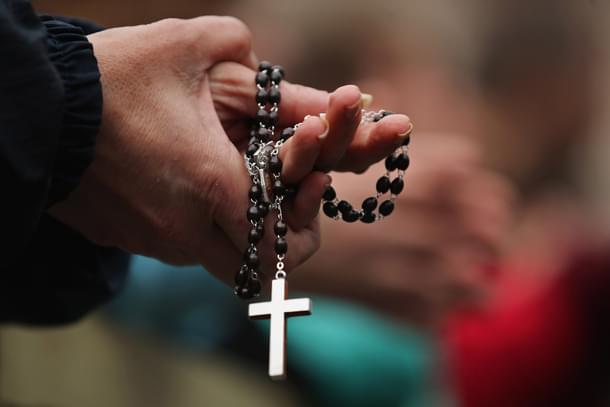Politics
Why The Church Dominates Tamil Nadu’s Aided Schools – And What Needs To Be Done
Surendranath N
Mar 08, 2021, 12:12 PM | Updated 12:12 PM IST
Save & read from anywhere!
Bookmark stories for easy access on any device or the Swarajya app.


Tamil Nadu’s private education sector shows the clear dominance of the Christian community. From the official statistics, we glean the following figures:
A. 42.7 per cent of Tamil Nadu’s students are enrolled in private unaided schools, 37.8 per cent in government schools and another 19.5 per cent in private-aided schools.
B. 64 per cent of all schools are run by the government, but their student bodies are an average of 126 students.
C. 14 per cent of schools are in the private-aided segment, with average student bodies of 286, while 21 per cent in the private unaided segment have an average student body of 414.
The private unaided schools cater to the urbanised section of Tamil Nadu that also has the capacity to pay fees. The 8,386 private-aided schools fulfil a critical role where they provide quality education under the supervision of private management but at a subsidised cost.
Often, they are able to provide free tuitions to the lower classes. They also often receive many of the benefits that the welfare state provides school children — mid-day meals, books, uniforms, footwear, bicycles, sanitary napkins, laptops, scholarships for needy girl students and for students from the backward classes (BCs), most backward classes (MBC), minority and Scheduled Caste/ Scheduled Tribes (SC/ST) communities.
Of these 8,386 schools, more than 3,000 are administered by the Tamil Nadu Catholic Education Council of South India. This is a body that functions under the Bishop’s Council and is, therefore, directly administered by the Roman Catholic Church.
There are eight dioceses of the Church of South India, among which the Tirunelveli Diocese alone runs 250-plus schools. One may safely assume that another 3,000 schools are run by the Church of South India. In addition, the churches run a large number of Teacher Training Institutes.
In contrast, the Muslim community of Tamil Nadu has a relatively smaller presence in education. There are only 56 government-aided Urdu medium schools and while Tamil Nadu subsidises madrassa education, there are hardly any takers for traditional education.
Furthermore, the community has not demonstrated an interest in opening educational institutions of a secular nature.
Advantages Of Christian Institutions
Let us begin by analysing the capital cost of providing education. The primary capital costs are the cost of land and the cost of construction.
Churches were allocated large parcels of land by the colonial British administration. This one case study shows the allocation of a parcel of 310 acres of land in 1923, which was subsequently transferred to the CSI Trust Association.
Additionally, the colonial Christian administration and subsequent secular governments allocated land for the purpose of constructing educational institutions on long-term leases under very favourable conditions.
Many of the schools were also constructed using foreign grants and using funds allocated by the government. State governments have competed with their predecessors in allocating funds for maintenance and repairs.
In addition, local parishes frequently conduct fund-raising events and drives to generate funds from the community and keep church properties, including educational institutions, in good repair.
Hindu-Run Schools
The Tamil Nadu Hindu Religious and Charitable Endowments Board (HRCE Board) owns in all 4.75 lakh acres of land, urban, agricultural and commercial, but runs no more than 36 schools.
The eight Saiva Siddhanta Mathams are said to be in possession of one lakh acres of land, but run barely a handful of schools. The Tirupanandal Matham is still running a few schools, but the Tiruvavaduthurai Adheenam’s schools have been taken over by HRCE.
The Sri Vaishnava Mathams are largely impoverished and the most progressive Ahobila Matham is not able to sustain more than a few schools. In this scenario, only the Kanchi Kamakoti Peetham stands out in the number of educational institutions that are run using the Matham’s network of donors.
Even if Hindu institutions wish to enter the private-aided schooling space, it is no longer possible, as no new private schools can be offered aid after the 1989 government order passed by Tamil Nadu. For existing schools, the government would not provide aid for classes and sections added after 1989.
The Genesis
In 1953, the government of Madras State found that the existing capacity in schools was simply not enough to meet the burgeoning demand. As a temporary solution, the then chief minister K Kamaraj hit upon the idea of helping private institutions enrol more students with the government taking the responsibility for paying teachers’ salaries. This was not a large fiscal burden at that point in time, since the monthly salary for a teacher was no more than Rs 50. The state had not introduced a defined pension scheme at that point in time.
However, in 2020, a teacher draws Rs 7 lakh as annual salary on average and is also entitled to a state pension. In anticipation of such a situation, the Tamil Nadu government of M Karunanidhi, in 1989, brought in an amendment to the 1966 act regulating private educational institutions.
Simultaneously, in 1991, private aided schools were allowed to start classes in English medium and additional fees could be raised.
School managements were able to cross-subsidise their Tamil medium schools through fees collected from separate English medium classes or English medium schools constructed on the same properties.
A special case is the few thousand clergymen and nuns who serve as teachers in private aided institutions. By canon law, any income that is earned by priests and nuns is counted as income to the church and is, hence, non-taxable.
In many private rural aided schools, the only way the school can continue to run is by taking a portion of the teacher's salary as kickback. Hindu teachers will have to pay a kickback to the school management as well as pay tax.
In the case of the clergy, their salary is tax-free. They get accommodation, food and clothing for free as they are priests. Hence, except for a small portion of their incomes that they retain for personal expenses, the entire amount is credited back to the church as earnings.
Many aided schools in urban regions have seen diminishing student bodies. However, rural schools have continued to have strong enrolments. At a gross level, there is a surplus of teachers, due to improving prosperity and increasing urbanisation.
As a result, the Madras High Court has ordered a freeze on new recruitment of teachers. This hides the fact that student bodies have not reduced in rural schools and retiring teachers have not been replaced with new appointments in rural schools.
While this affects all aided schools, it is particularly hard on non-minority schools. As a result, non-minority schools are being squeezed out of the space.
Suggestions
Government aid to these private schools fulfils a key gap in rural education. Uniform treatment for all teachers’ salaries will be one form of making the playing field even. Additionally, reallocating surplus teachers from urban schools with dwindling student bodies to struggling rural schools will also help redress this imbalance.
We saw the reasons and the history behind the remarkable dominance of Christian institutions in the private-aided segment, which caters to 19.5 per cent of the student body. But, due to older sunk costs and the ability to cross-subsidise unaided English medium schools and the ability to utilise government-paid salaries to teachers, the schools can extend their footprint even wider.
Hindu religious institutions, if freed from governmental control, can enter this space without having to rely on government aid.
According to independent analysts, if Hindu religious institutions are allowed to operate freely and realise market-related incomes from their properties, they can operate as many as 10,000 schools and cater to more than 25 per cent of school going children. This will drive down costs of education and also give the Hindus of Tamil Nadu institutional capacity.





